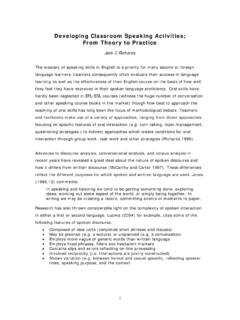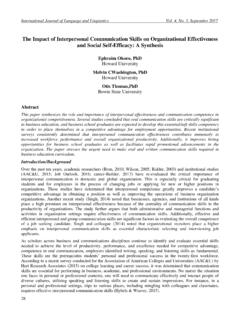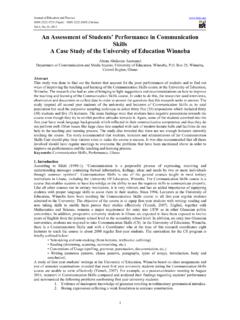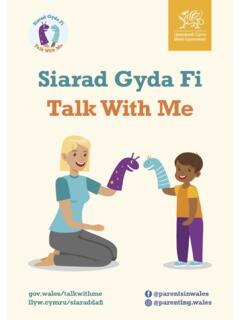Transcription of The Use of the Communicative Language Teaching Approach …
1 English Language Teaching ; Vol. 12, No. 1; 2019 ISSN 1916-4742 E-ISSN 1916-4750 Published by Canadian Center of Science and Education 110 The Use of the Communicative Language Teaching Approach to Improve Students oral Skills Vanessa Toro1, Gina Camacho-Minuche1, Eliana Pinza-Tapia1 & Fabian Paredes1 1 Universidad T cnica Particular de Loja, Ecuador Correspondence: Vanessa Toro, Universidad T cnica Particular de Loja, Ecuador. Received: October 28, 2018 Accepted: December 11, 2018 Online Published: December 14, 2018 doi: URL: Abstract The purpose of this study is to determine the use of the Communicative Language Teaching Approach in the English classroom and the strategies and resources used by the teachers to improve students oral skills.
2 The participants were 6 English teachers and 105 students enrolled in the 2nd, 3rd, and 4th grades at a public elementary school in the city of Loja, located at the southern part of Ecuador. A mixed method Approach was applied in this study. In order to collect the data, a questionnaire was given to the English teachers and class observations were carried out. The results obtained throughout this study reveal that modeling, repetition, pair and group work are the main strategies used by teachers to help students develop Communicative competences. These strategies were frequently used but still not enough to promote active participation during classes.
3 It is important to highlight that there is a variety of strategies besides the ones previously mentioned that can be incorporated to offer students more opportunities to orally produce the Language . Additionally, teachers provide different kinds of feedback such as metalinguistic feedback and elicitation as a way to help students improve their oral skills. Keywords: Communicative Language Teaching , EFL Teaching , feedback, strategies, oral skills 1. Introduction There are different methods that are being used to teach English as a foreign Language but not all of them help us to reach the desired Communicative goals; therefore, the selection and application of the most effective ones is required.
4 In Ecuador, the lack of appropriate methods, techniques, and strategies for Teaching English is providing poor results in the oral production of the Language . The study conducted by Calle, Calle, Argudo, Moscoso, Smith, and Cabrera (2012) indicates that the strategies teachers use in the English classroom are based on traditional methods that do not focus on the Communicative Language Teaching Approach as it is established by the Ministry of Education and Culture of Ecuador. They also highlight that English classes are teacher-centered rather than student-centered and most of them are conducted in Spanish which limit the acquisition of the target Language .
5 It is also necessary to mention that the English curriculum in Ecuador has established that for the subnivel de b sica elemental (2nd, 3rd, and 4th grades) and for the subnivel de b sica media (5th, 6th, and 7th grades), students receive 3 hours of English classes during the week; for the subnivel de b sica superior (8th, 9th, and 10th grades), students receive 5 hours of English classes per week. With respect to Bachillerato General Unificado , students from 1st and 2nd grades receive 5 hours of English per week while the students from 3rd grade receive 3 hours per week; consequently, the time assigned for English classes in Ecuador are not sufficient for students to develop their Communicative competence.
6 Additionally, according to the results obtained by the British Council (2015), English learners in Ecuador show more confidence at the time of reading and writing but they do not have much confidence in speaking. English learners consider speaking harder than writing and reading and the only contact they have with the Language is in classes, besides that, they do not count on teachers who use appropriate strategies to encourage them to produce the Language . As a solution to this problem, the English curriculum of Ecuador 2016 was improved considering the Communicative Language Teaching Approach as one of the core principles.
7 This Approach involves learning a Language through interaction and communication, rather than learning it through memorization of different aspects of the Language system. For this reason, the purpose of this study is to determine if the Communicative Language Teaching Approach is being used in the English classroom to improve students oral skills and which strategies and resources are mainly used by teachers regarding this Approach . Finally, English teachers and education authorities will benefit from these results because of the valuable information about the implementation of the English Language Teaching Vol.
8 12, No. 1; 2019 111 Communicative Language Teaching Approach in the English classroom they will provide. These results will represent a great source of information about the community involved in the educational field which will contribute to the improvement of the Teaching and learning Language process in the use of appropriate methods. 2. Literature Review Communicative Language Teaching Approach All human beings need to communicate in order to express their ideas, feelings and thoughts, this is the main reason why Communicative activities should be integrated into the lesson. Students spoken Language is more productive when they are engaged in a dynamic learning environment that encourages them to do their tasks.
9 It is well-known that all people need to understand spoken Language in different situations, such as daily life, work, school, community, among others. According to Moss and Ross-Feldman (2003), any activity which requires the learner to speak and listen to others includes the use of communication. Activities with Communicative purposes are helpful for breaking down barriers, finding information, expressing ideas about oneself and learning about culture. Jeyasala (2014) asserts that teachers should encourage students Communicative competence all the time, and besides their limitations to use Language fluently and accurately, they should provide them with spaces to interact with others or to immerse them in speaking activities that enhance their ability to use the target Language .
10 Providing students with real Communicative contexts is the best option teachers can make, because students can exchange real information, so Language and phrases will emerge according to the situation. It is also necessary that students have a lot of exposure to the Language , the linguistic input they receive should provide them with opportunities to produce and use the Language at any situation, motivation then plays a very important role in encouraging students to verbally communicate. According to Richards (2006), learning the Language does not always guarantee the learner will be able to use the Language fluently.


















